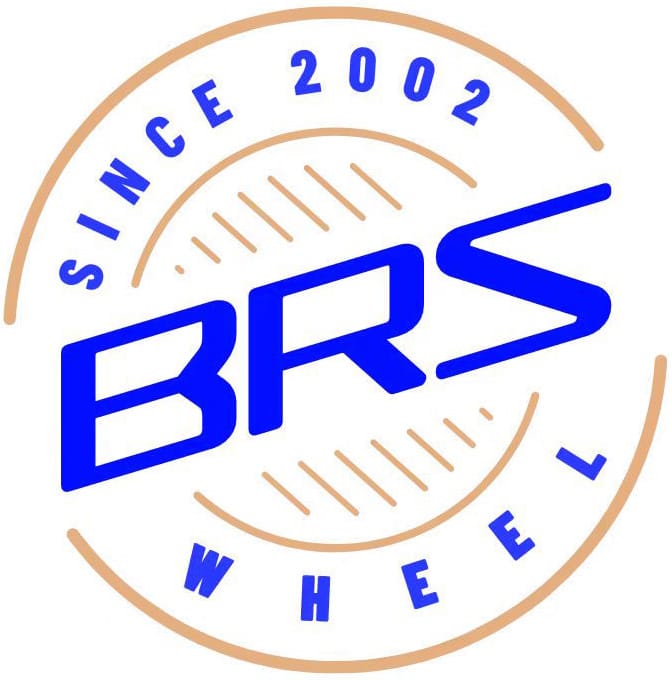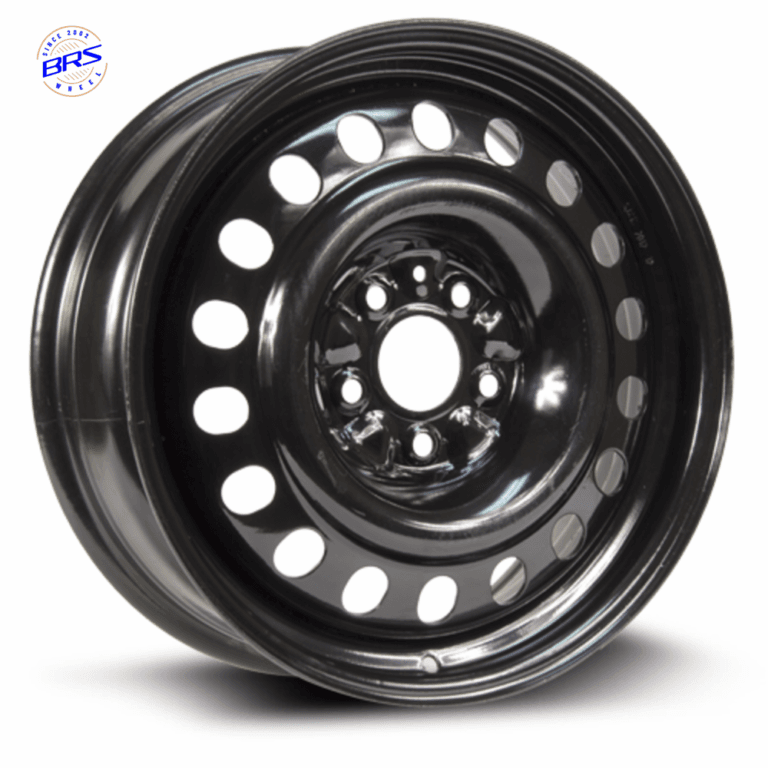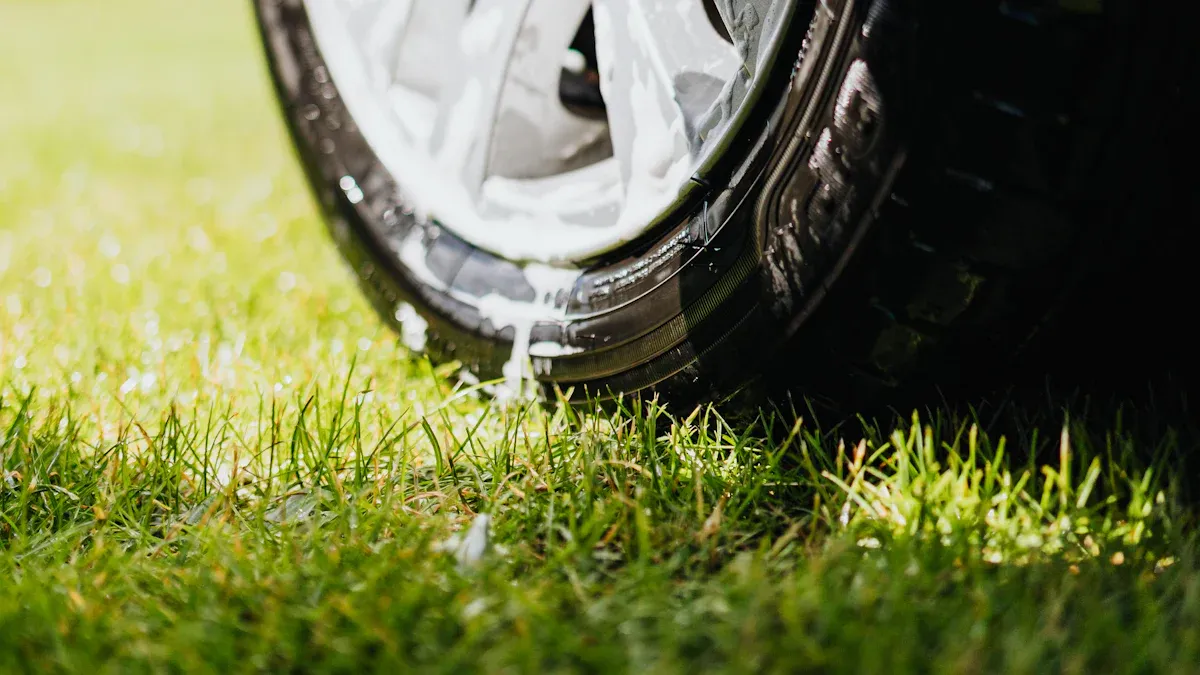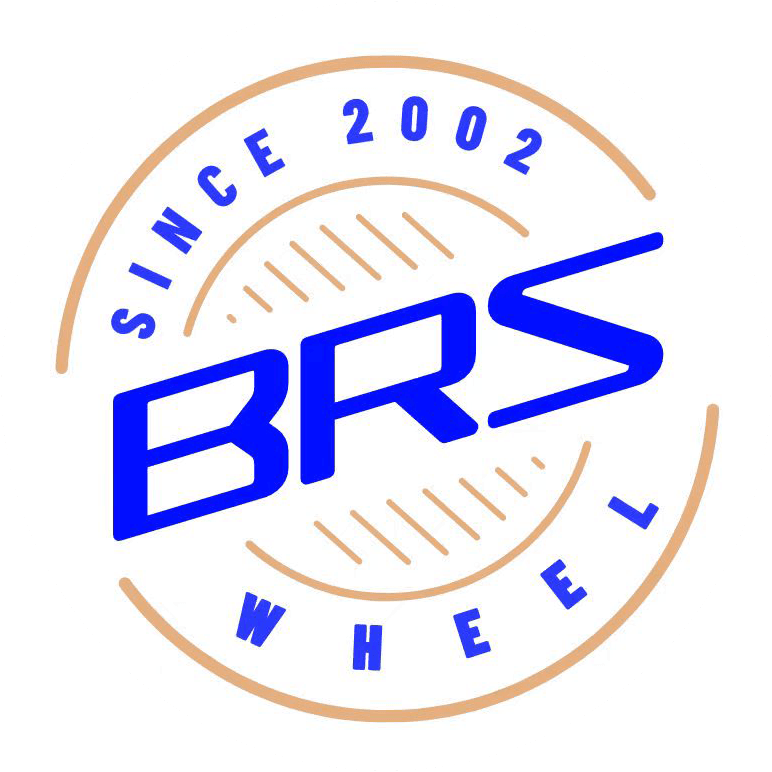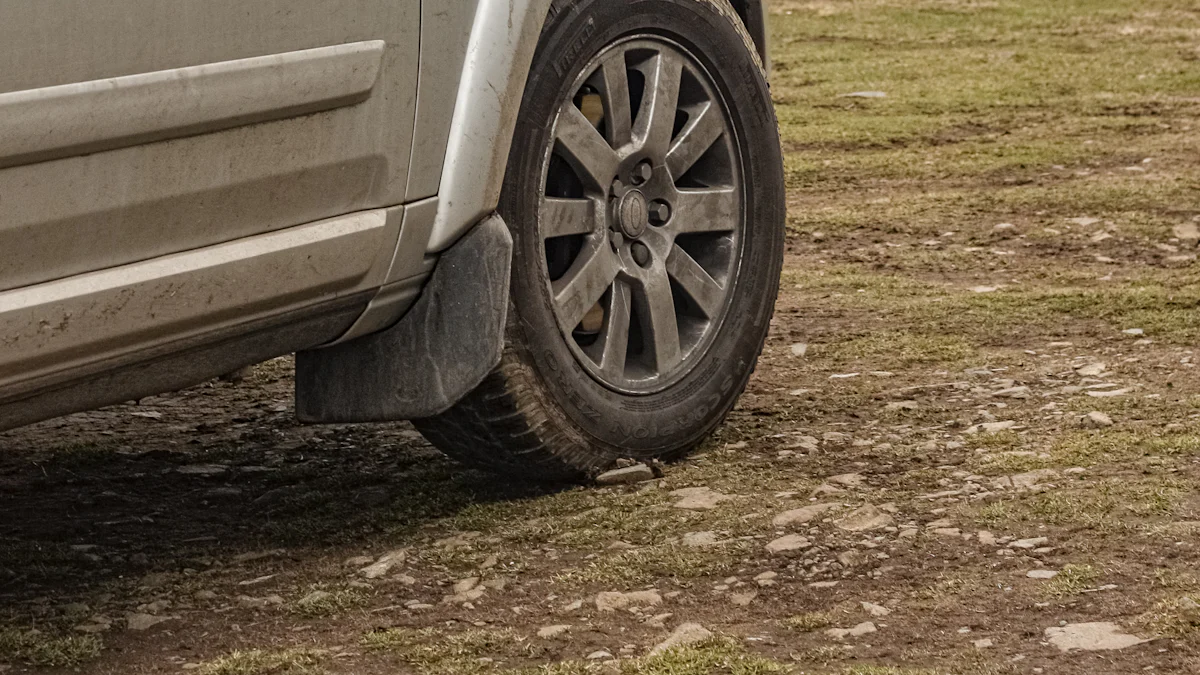
A 16×8 wheel offers the perfect balance of width and performance for off-road adventures. Its design ensures optimal handling and stability, even on rugged terrains. The 8-inch width provides excellent support for a variety of tire sizes, enhancing traction and control. This wheel size also maintains vehicle balance, which is crucial for safety during challenging drives. Its compatibility with different vehicles and terrains makes it a versatile choice. By selecting the right 16×8 wheel, you can significantly improve your off-road experience, ensuring both durability and reliability in extreme conditions.
Key Takeaways
- Understand the significance of ’16×8′ sizing: The diameter and width of the wheel are crucial for off-road performance, affecting handling, stability, and compatibility with various tire sizes.
- Ensure lug pattern compatibility: Always measure your vehicle’s lug pattern to avoid improper fitment, which can lead to safety issues during off-road driving.
- Choose the right material: Steel wheels offer durability for extreme conditions, while alloy wheels provide lighter weight and better handling. Select based on your off-road needs.
- Consider offset and backspacing: A slight negative offset is often preferred for off-road use, improving suspension clearance and preventing rubbing against fenders.
- Match tire size to your wheels: Use tire sizes that align with your 16×8 wheels, typically ranging from 245 mm to 285 mm in width, to ensure optimal traction and performance.
- Regular maintenance is key: Clean your wheels after off-road trips, inspect for damage, and maintain proper tire pressure to extend the lifespan of your wheels and tires.
- Consult professionals for fitment: If you’re unsure about compatibility or specifications, seek expert advice to ensure you make informed decisions for your off-road setup.
Understanding 16×8 Wheel Specifications
Dimensions and Sizing
What “16×8” means and its importance for off-road use.
The term “16×8” refers to the wheel’s diameter and width. The “16” indicates the wheel’s diameter in inches, while the “8” represents its width. This sizing is crucial for off-road use because it balances performance and durability. A 16-inch diameter provides enough clearance for larger brake systems, which are often necessary for off-road vehicles. The 8-inch width supports a wide range of tire sizes, ensuring better traction and stability on uneven terrains. Choosing the right size ensures your vehicle performs optimally, especially in challenging conditions.
How wheel width and diameter impact off-road performance.
Wheel width and diameter directly affect how your vehicle handles off-road. A wider wheel, like an 8-inch one, allows for mounting wider tires. Wider tires increase the contact area with the ground, improving grip and control. The 16-inch diameter strikes a balance between maintaining sidewall flexibility and reducing sidewall flex. This combination enhances handling and stability on rocky or muddy trails. Proper sizing also prevents unnecessary strain on your suspension system, ensuring a smoother ride.
Lug Patterns and Bolt Circles
Measuring lug patterns for compatibility.
Lug patterns, also known as bolt patterns, determine how the wheel attaches to your vehicle. To measure a lug pattern, count the number of lug holes and measure the diameter of the circle they form. For example, a 6×139.7 pattern means six lug holes arranged in a circle with a 139.7 mm diameter. Ensuring compatibility between your vehicle’s hub and the wheel’s lug pattern is essential for safety and performance. Incorrect patterns can lead to improper fitment, causing vibrations or even wheel detachment during off-road adventures.
Common bolt patterns for off-road vehicles.
Off-road vehicles often use specific bolt patterns to accommodate their rugged design. Common patterns include 5×114.3, 6×139.7, and 8×165.1. These patterns are designed to handle the stress of off-road driving. For instance, a 6×139.7 pattern is frequently found on trucks and SUVs, offering a secure fit for heavy-duty applications. Knowing your vehicle’s bolt pattern helps you select a 16×8 wheel that fits perfectly and performs reliably in extreme conditions.
Offset and Backspacing
The role of offset in wheel positioning and suspension clearance.
Offset refers to the distance between the wheel’s mounting surface and its centerline. A positive offset places the wheel closer to the vehicle’s body, while a negative offset pushes it outward. For off-road use, a slight negative offset is often preferred. It improves suspension clearance and prevents the wheel from rubbing against the fenders. Proper offset ensures your wheels align correctly with the suspension, enhancing stability and preventing damage during rough rides.
How backspacing affects vehicle handling and fitment.
Backspacing measures the distance from the wheel’s mounting surface to its inner edge. It determines how far the wheel sits inside the wheel well. For a 16×8 wheel, backspacing typically ranges from 4 to 5 inches. Proper backspacing ensures the tire stays within the fender, protecting it from debris. It also affects handling by maintaining the correct alignment of the wheel with the suspension. Choosing the right backspacing prevents issues like tire rubbing or poor steering response, ensuring a safer and more enjoyable off-road experience.
Material and Construction
Comparing steel and alloy wheels for off-road durability.
When selecting a 16×8 wheel for off-road adventures, the material plays a critical role in determining its durability and performance. Steel and alloy are the two primary materials used in wheel construction, each offering unique advantages for off-road use.
Steel wheels are renowned for their strength and resilience. They can withstand harsh impacts from rocks, debris, and uneven terrains without cracking. This makes them an excellent choice for extreme off-road conditions where durability is a top priority. Steel wheels are also more affordable, making them a practical option for budget-conscious off-road enthusiasts. However, they tend to be heavier, which can slightly affect vehicle handling and fuel efficiency.
Alloy wheels, on the other hand, are lighter and more visually appealing. Their reduced weight improves handling and responsiveness, especially on rough trails. This lighter construction also reduces unsprung weight, which enhances suspension performance and overall ride quality. Alloy wheels often feature advanced designs and finishes, making them a popular choice for those who value aesthetics alongside functionality. While they are less prone to rust, they may not be as robust as steel wheels in extreme conditions.
For off-road enthusiasts, the choice between steel and alloy wheels depends on your priorities. If you frequently tackle rugged terrains and need maximum durability, steel wheels are a reliable option. If you prefer improved handling and a stylish appearance, alloy wheels may better suit your needs.
Weight considerations and their impact on performance.
The weight of a 16×8 wheel significantly influences your vehicle’s off-road performance. Heavier wheels, such as those made of steel, increase the overall weight of your vehicle. This added weight can reduce acceleration and fuel efficiency. However, it also provides stability, which is beneficial when navigating rocky or uneven surfaces.
Lighter wheels, like those made of alloy, offer distinct advantages. They reduce unsprung weight, which refers to the weight not supported by the suspension system. Lower unsprung weight improves suspension responsiveness, allowing your vehicle to adapt more effectively to changes in terrain. This results in smoother handling and better control during off-road adventures.
Additionally, lighter wheels place less strain on your vehicle’s drivetrain and braking system. This can extend the lifespan of these components, reducing maintenance costs over time. However, lighter wheels may sacrifice some durability, especially in extreme off-road conditions.
When choosing a 16×8 wheel, consider the type of terrain you will encounter most often. For rocky or challenging trails, a heavier steel wheel may provide the durability you need. For mixed terrains or lighter off-road use, an alloy wheel’s reduced weight can enhance your driving experience.
Compatibility with Vehicles and Terrains
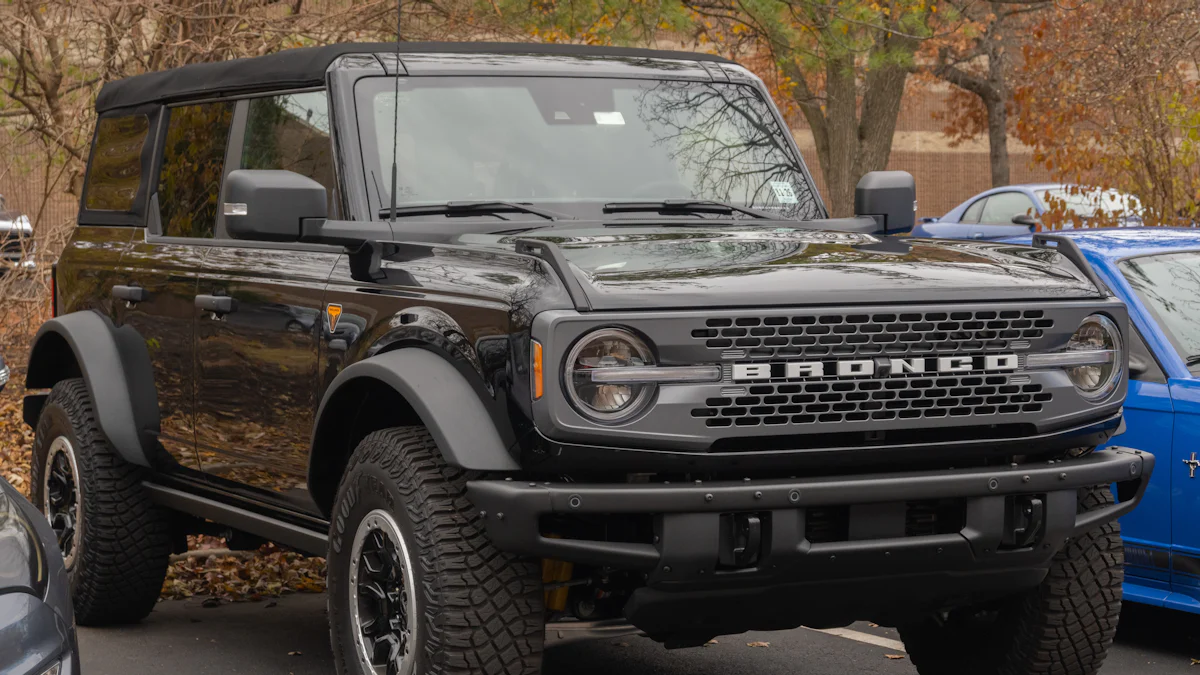
Matching 16×8 Wheels to Your Vehicle
How to determine if 16×8 wheels fit your vehicle.
Start by checking your vehicle’s owner manual or consulting the manufacturer’s specifications.
You should also measure the wheel offset and backspacing. Offset determines how far the wheel sits from the hub, while backspacing ensures the wheel doesn’t interfere with suspension components or fenders. A slight negative offset often works best for off-road vehicles, as it improves clearance and stability. Additionally, confirm that the wheel’s load rating can handle the weight of your vehicle, especially if you carry heavy gear during off-road trips.
Examples of popular off-road vehicles that use 16×8 wheels.
Many off-road vehicles are compatible with 16×8 wheels due to their versatility and performance benefits. Popular models include the Toyota Tacoma, Jeep Wrangler, Ford Ranger, and Nissan Frontier. These vehicles often feature robust designs that pair well with the durability and stability of 16×8 wheels. For instance, the Jeep Wrangler benefits from the wider stance provided by these wheels, enhancing its grip on rocky trails. Similarly, the Toyota Tacoma uses 16×8 wheels to balance traction and handling on muddy or sandy terrains.
Choosing Wheels for Specific Terrains
Best 16×8 wheels for rocky, muddy, and sandy terrains.
Different terrains demand specific wheel features to optimize performance. For rocky terrains, steel wheels are an excellent choice. Their strength and resistance to impact make them ideal for navigating sharp rocks and uneven surfaces. Muddy terrains benefit from wheels with a slight negative offset, as this positioning prevents mud buildup and improves tire clearance. Alloy wheels, with their lighter weight, perform well on sandy terrains by reducing strain on the vehicle and improving maneuverability.
When selecting a 16×8 wheel for a specific terrain, consider the material and design. Steel wheels offer unmatched durability for extreme conditions, while alloy wheels provide better handling and responsiveness on softer surfaces. Choose a wheel that aligns with the challenges of your preferred off-road environment.
How terrain impacts wheel design and material choice.
The terrain you drive on significantly influences the ideal wheel design and material. Rocky trails require wheels that can withstand heavy impacts, making steel wheels the preferred option. Their sturdiness ensures they won’t crack under pressure. Muddy terrains demand wheels with designs that prevent debris accumulation, such as those with open spokes. Sandy terrains, on the other hand, benefit from lightweight alloy wheels. Their reduced weight minimizes the risk of sinking and enhances vehicle control.
Wheel material also affects performance. Steel wheels excel in durability but add weight, which can impact acceleration. Alloy wheels, while lighter and more visually appealing, may not endure harsh impacts as effectively. Understanding the terrain helps you make an informed decision when choosing the right 16×8 wheel.
Suspension and Lift Kit Considerations
How lift kits affect wheel compatibility.
Lift kits modify your vehicle’s suspension height, which directly impacts wheel compatibility. By raising the vehicle, lift kits create additional clearance for larger wheels like 16×8. This added space prevents the wheels from rubbing against the fenders or suspension components during off-road maneuvers. However, not all lift kits are compatible with every wheel size. You must ensure that the lift kit matches the dimensions and offset of your chosen wheels.
Lift kits also alter the vehicle’s center of gravity. While this improves ground clearance, it may affect stability. Pairing the right lift kit with 16×8 wheels ensures optimal performance and safety during off-road adventures.
Adjusting suspension for larger wheels and off-road performance.
Installing larger wheels like 16×8 often requires suspension adjustments to maintain proper alignment and handling. Begin by checking the suspension geometry. Larger wheels can change the angle of the suspension components, leading to uneven tire wear or poor steering response. Adjusting the suspension ensures the wheels align correctly with the vehicle’s frame.
You may also need to upgrade certain suspension components, such as shocks or control arms, to accommodate the increased weight and size of the wheels. These upgrades enhance the vehicle’s ability to absorb impacts and maintain stability on rough terrains. Proper suspension adjustments maximize the performance of your 16×8 wheels, ensuring a smoother and safer off-road experience.
Factory vs. Aftermarket 16×8 Wheels
Factory Wheels
Advantages of OEM 16×8 wheels for off-road use.
Original Equipment Manufacturer (OEM) wheels, often referred to as factory wheels, are specifically designed to match your vehicle’s specifications. These wheels ensure a perfect fit, eliminating concerns about compatibility. For off-road use, OEM 16×8 wheels provide reliability and durability. Manufacturers rigorously test these wheels to meet safety and performance standards, making them a dependable choice for rugged terrains.
Factory wheels also maintain the original design and engineering of your vehicle. This ensures optimal handling and stability during off-road adventures. For example, the Jeep Wrangler Rubicon comes equipped with factory 16×8 wheels paired with Goodyear MTRs in size 245/75-16. This combination delivers excellent traction and control on rocky and muddy trails. Choosing OEM wheels guarantees that your vehicle performs as intended by the manufacturer.
Limitations of factory wheels in extreme conditions.
While factory wheels excel in compatibility and reliability, they may not always meet the demands of extreme off-road conditions. These wheels often prioritize general-purpose use over specialized performance. For instance, factory wheels may lack the customization options needed for specific terrains like deep mud or loose sand. Additionally, their designs might not accommodate larger tires or lift kits, limiting your ability to modify your vehicle for advanced off-road challenges.
Factory wheels also tend to have a more conservative offset, which may not provide the wider stance preferred by off-road enthusiasts. This can affect stability and clearance when navigating uneven terrains. If you plan to push your vehicle to its limits, aftermarket options might offer better solutions.
Aftermarket Wheels
Benefits of customization and performance upgrades.
Aftermarket 16×8 wheels open up a world of customization and performance enhancements. These wheels allow you to tailor your vehicle to specific off-road needs. You can choose from a variety of materials, designs, and finishes to match your style and functional requirements. For instance, Pro Comp steel wheels with 3.5-inch backspacing provide a wider stance, improving stability and clearance on rugged trails.
Performance upgrades are another significant advantage of aftermarket wheels. Lightweight alloy options reduce unsprung weight, enhancing handling and responsiveness. Some aftermarket wheels, like the Circuit Performance Metal Wheels, combine durability with a sleek design, making them ideal for mixed terrains. These wheels also accommodate larger tires, giving you better traction and control in challenging environments.
Potential downsides of aftermarket wheels.
Despite their benefits, aftermarket wheels come with certain drawbacks. Compatibility issues can arise if the bolt pattern, offset, or backspacing does not match your vehicle. Improper fitment can lead to vibrations, poor handling, or even damage to suspension components. It’s crucial to verify these specifications before purchasing.
Aftermarket wheels may also lack the rigorous testing standards of OEM options. While many brands prioritize quality, some lower-cost options might compromise durability. This could result in cracks or bends during extreme off-road use. Additionally, the cost of high-quality aftermarket wheels can be significantly higher than factory alternatives, especially when factoring in installation and potential modifications.
Cost and Value Comparison
Price differences between factory and aftermarket 16×8 wheels.
Factory wheels are generally more affordable upfront, as they come included with your vehicle. Replacements or upgrades through the manufacturer often cost less than premium aftermarket options. However, factory wheels may lack the specialized features that justify the higher price of aftermarket alternatives.
Aftermarket wheels vary widely in price based on material, design, and brand. Steel options, like Pro Comp wheels, are budget-friendly and durable, making them a popular choice for off-road enthusiasts. Alloy wheels, while more expensive, offer superior performance and aesthetics. The additional cost of aftermarket wheels often reflects their enhanced functionality and customization options.
Long-term value and durability considerations.
When evaluating long-term value, both factory and aftermarket wheels have their merits. Factory wheels provide consistent performance and require minimal maintenance, making them a cost-effective choice for general off-road use. Their durability ensures they last as long as your vehicle under normal conditions.
Aftermarket wheels, on the other hand, offer greater versatility and performance benefits. High-quality options, such as Pro Comp steel wheels, withstand harsh impacts and extreme terrains, reducing the need for frequent replacements. Lightweight alloy wheels improve fuel efficiency and reduce wear on suspension components, adding value over time. While the initial investment may be higher, aftermarket wheels often deliver better durability and performance in demanding environments.
Tire Pairing for 16×8 Wheels

Choosing the Right Tire Size
Matching tire width and diameter to 16×8 wheels.
Selecting the correct tire size for your 16×8 wheel is essential for achieving optimal performance and safety during off-road adventures. The width of the tire must align with the 8-inch wheel width to ensure proper fitment and functionality. Tires that are too narrow may not seat correctly on the wheel, while excessively wide tires can lead to sidewall instability. A common recommendation for 16×8 wheels includes tire widths ranging from 245 mm to 285 mm. These sizes provide a balanced contact patch, improving traction and control on uneven terrains.
The diameter of the tire also plays a critical role. For a 16-inch wheel, compatible tire diameters typically range between 30 inches and 33 inches, depending on your vehicle’s suspension setup and intended use. Larger diameters enhance ground clearance, which is beneficial for rocky or muddy trails. However, always verify that the chosen tire size does not interfere with your vehicle’s fenders or suspension components.
Common tire sizes for off-road setups.
Off-road enthusiasts often rely on specific tire sizes that pair well with 16×8 wheels. Popular options include:
- 265/75R16: This size offers a versatile balance of width and height, making it suitable for various terrains.
- 285/75R16: A wider option that provides increased traction and stability, especially on loose surfaces like sand or gravel.
- 245/75R16: Ideal for vehicles with limited clearance, this size maintains excellent handling while reducing the risk of rubbing.
These sizes cater to different off-road needs, ensuring you can tackle diverse terrains with confidence.
Off-Road Tire Types
All-terrain vs. mud-terrain tires for 16×8 wheels.
When choosing tires for your 16×8 wheel, understanding the differences between all-terrain (A/T) and mud-terrain (M/T) tires is crucial.
All-terrain tires are designed for versatility. They perform well on a mix of paved roads and off-road trails. Their tread patterns feature interlocking blocks that provide decent traction on dirt, gravel, and light mud. A/T tires are an excellent choice if you frequently switch between on-road and off-road driving. They also offer a quieter ride and better fuel efficiency compared to M/T tires.
Mud-terrain tires, on the other hand, excel in extreme off-road conditions. Their aggressive tread patterns and larger voids allow them to dig into soft surfaces like mud and loose dirt. These tires provide superior grip in challenging environments but may produce more road noise and wear faster on paved surfaces. If your adventures primarily involve rugged trails, M/T tires are the better option.
Specialty tires for sand, snow, and rock crawling.
Certain terrains require specialized tires to maximize performance. For sandy environments, look for tires with wide footprints and shallow tread patterns. These features help distribute weight evenly, reducing the risk of sinking. Snowy conditions demand tires with deeper grooves and siping to enhance grip on slippery surfaces. Rock crawling benefits from tires with reinforced sidewalls and flexible rubber compounds, which improve durability and traction on sharp, uneven rocks.
Specialty tires cater to specific challenges, ensuring your 16×8 wheel setup performs reliably in any environment.
Balancing Performance and Comfort
How tire pressure affects off-road handling.
Tire pressure significantly impacts your vehicle’s handling and comfort during off-road adventures. Lowering the tire pressure increases the contact area between the tire and the ground, improving traction on soft surfaces like sand or mud. This technique, known as “airing down,” also enhances shock absorption, providing a smoother ride over rough terrain.
However, excessively low pressure can lead to sidewall damage or tire bead separation. Always follow the manufacturer’s recommendations for minimum and maximum pressure levels. For most off-road scenarios, reducing tire pressure by 20-30% from the standard on-road level works effectively.
Tips for maintaining tire and wheel performance.
Proper maintenance ensures the longevity and performance of your tires and wheels. After each off-road trip, inspect your tires for cuts, punctures, or uneven wear. Clean the wheels to remove mud, sand, or debris that could cause corrosion or imbalance. Regularly check tire pressure and adjust it according to the terrain you plan to tackle.
Rotating your tires every 5,000 to 7,000 miles helps distribute wear evenly, extending their lifespan. Additionally, balancing and aligning your wheels periodically ensures optimal handling and reduces strain on suspension components. These practices keep your 16×8 wheel and tire setup in top condition, ready for your next adventure.
Troubleshooting and Tips for Choosing 16×8 Wheels
Common Mistakes to Avoid
Overlooking lug pattern compatibility
One of the most common mistakes when selecting a 16×8 wheel is ignoring the lug pattern compatibility. The lug pattern, also called the bolt pattern, determines how the wheel attaches to your vehicle. If the lug pattern does not match your vehicle’s hub, the wheel will not fit properly. This can lead to unsafe driving conditions, including vibrations or even wheel detachment during off-road use. For example, a 6×139.7 lug pattern is common for trucks and SUVs, while other vehicles may require a 5×114.3 pattern. Always measure the lug pattern carefully or consult your vehicle’s manual to ensure a perfect fit.
Choosing wheels that are too wide or narrow for your vehicle
Another frequent error involves selecting wheels that are either too wide or too narrow for your vehicle. A 16×8 wheel offers an ideal balance of width and performance, but pairing it with the wrong tire size can compromise handling and safety. For instance, mounting a tire that is too narrow on an 8-inch-wide wheel can cause improper seating, while an excessively wide tire may lead to sidewall instability. Stick to recommended tire sizes, such as 265/75R16 or 285/75R16, to ensure optimal performance and safety. Proper sizing also prevents unnecessary strain on your suspension system, enhancing your off-road experience.
Maintenance Tips for Off-Road Wheels
Cleaning and protecting wheels from rust and damage
Off-road adventures expose your wheels to harsh conditions, including mud, water, and debris. Regular cleaning is essential to prevent rust and damage, especially for steel wheels. Use a mild soap and water solution to remove dirt and grime after every trip. For stubborn stains, a soft brush can help without scratching the surface. Applying a protective coating or wax can further shield your wheels from corrosion. Alloy wheels, while less prone to rust, still benefit from regular cleaning to maintain their finish and durability.
Inspecting wheels for wear and tear after off-road use
Frequent off-road use can cause wear and tear on your wheels. Inspect them thoroughly after each trip to identify any cracks, dents, or bends. Pay close attention to the inner and outer edges, as these areas often sustain the most damage. For steel wheels, check for signs of rust or corrosion. Alloy wheels should be examined for chips or scratches that could weaken their structure. Addressing these issues promptly ensures your wheels remain safe and reliable for future adventures.
Expert Advice for First-Time Buyers
Consulting professionals for proper fitment
If you are new to off-road wheels, consulting a professional can save you time and money. Experts can help you determine the right specifications for your vehicle, including lug pattern, offset, and backspacing. They can also recommend the best materials and designs based on your off-road needs. For instance, if you frequently tackle rocky terrains, a professional might suggest durable steel wheels with a slight negative offset for better clearance. Seeking expert advice ensures you make an informed decision and avoid costly mistakes.
Testing wheels and tires before making a purchase
Before finalizing your purchase, test the wheels and tires to ensure they meet your expectations. Many retailers offer trial fittings, allowing you to check compatibility with your vehicle. Testing helps you confirm that the 16×8 wheel fits properly and aligns with your suspension system. It also gives you a chance to evaluate the wheel’s performance and appearance. For example, you can test how a specific tire size, such as 265/75R16, performs on your chosen wheel. Taking this step ensures you invest in a setup that enhances your off-road experience.
Choosing the right 16×8 wheel transforms your off-road adventures. It enhances stability, durability, and performance across challenging terrains. Understanding specifications like offset, backspacing, and lug patterns ensures a perfect fit for your vehicle. Pairing the wheels with suitable tires further optimizes traction and handling. Always consult professionals to confirm compatibility and test your setup before committing. Start by identifying your vehicle’s needs and the terrain you plan to conquer. This approach guarantees a safer, more enjoyable off-road experience while maximizing your investment.
FAQ
What does “16×8” mean in wheel specifications?
The term “16×8” refers to the wheel’s diameter and width. The “16” represents the diameter of the wheel in inches, while the “8” indicates its width in inches. This sizing is essential for off-road vehicles because it balances performance and durability. A 16-inch diameter provides enough clearance for larger brake systems, and the 8-inch width supports a variety of tire sizes, ensuring better traction and stability on uneven terrains.
How do I know if 16×8 wheels will fit my vehicle?
To determine if 16×8 wheels fit your vehicle, check your owner’s manual or consult the manufacturer’s specifications. Focus on the bolt pattern, offset, and backspacing. The bolt pattern must match your vehicle’s hub, while the offset and backspacing ensure proper alignment with the suspension and fenders. You can also consult a professional or use online tools to confirm compatibility.
What are the benefits of using 16×8 wheels for off-road adventures?
16×8 wheels offer several advantages for off-road use:
- Enhanced Stability: The 8-inch width provides a wider stance, improving balance on uneven terrains.
- Improved Traction: Wider wheels allow for mounting larger tires, increasing the contact area with the ground.
- Durability: These wheels are designed to handle the stress of off-road conditions, ensuring reliability during rugged adventures.
By choosing 16×8 wheels, you can optimize your vehicle’s performance and safety on challenging trails.
Should I choose steel or alloy 16×8 wheels for off-road use?
Your choice depends on your priorities:
- Steel Wheels: Known for their strength and resilience, steel wheels withstand harsh impacts from rocks and debris. They are more affordable but heavier, which can slightly affect handling.
- Alloy Wheels: Lighter and more visually appealing, alloy wheels improve handling and responsiveness. They reduce unsprung weight, enhancing suspension performance. However, they may not be as robust as steel wheels in extreme conditions.
If durability is your priority, go for steel. If you value improved handling and aesthetics, alloy wheels are a better option.
What tire sizes work best with 16×8 wheels?
Common tire sizes for 16×8 wheels include:
- 265/75R16: Offers a versatile balance of width and height, suitable for various terrains.
- 285/75R16: Provides increased traction and stability, especially on loose surfaces.
- 245/75R16: Ideal for vehicles with limited clearance, maintaining excellent handling.
Choose a tire size that aligns with your vehicle’s specifications and the terrain you plan to tackle.
How does wheel offset affect off-road performance?
Offset determines the wheel’s positioning relative to the vehicle’s body. A slight negative offset is often preferred for off-road use. It pushes the wheel outward, improving suspension clearance and preventing rubbing against the fenders. Proper offset enhances stability and ensures the wheels align correctly with the suspension, which is crucial for navigating rough terrains.
Can I use 16×8 wheels with a lift kit?
Yes, 16×8 wheels are compatible with lift kits. Lift kits raise your vehicle’s suspension, creating additional clearance for larger wheels. This prevents the wheels from rubbing against the fenders or suspension components. Ensure the lift kit matches the dimensions and offset of your chosen wheels to maintain proper alignment and handling.
What are the common mistakes to avoid when choosing 16×8 wheels?
Avoid these common errors:
- Ignoring Lug Pattern Compatibility: Ensure the wheel’s bolt pattern matches your vehicle’s hub to avoid improper fitment.
- Choosing Incorrect Width: Pairing a tire that is too narrow or wide with an 8-inch wheel can compromise safety and performance.
- Overlooking Offset and Backspacing: Incorrect measurements can lead to rubbing or poor handling.
Pay attention to these factors to ensure a safe and reliable setup.
How do I maintain my 16×8 wheels after off-road use?
Proper maintenance extends the lifespan of your wheels:
- Clean Regularly: Remove mud, sand, and debris to prevent rust or corrosion. Use mild soap and water for cleaning.
- Inspect for Damage: Check for cracks, dents, or bends after each trip. Address issues promptly to ensure safety.
- Protect the Finish: Apply a protective coating or wax to shield the wheels from harsh elements.
Regular maintenance keeps your wheels in top condition for future adventures.
Why is selecting the right wheel width important for off-road tires?
Wheel width directly impacts tire performance and vehicle balance. For example, if you plan to use 285mm-wide tires, you’ll need an 8-inch or wider wheel to ensure proper fitment. A correctly matched width maximizes traction, improves handling, and prevents sidewall instability. By selecting the right width, you enhance your vehicle’s performance and ensure a smoother ride on any terrain.
Related Blog
What Are Off-Road Wheels Made Of?
How to Choose the Best American Off-Road Wheels?`
Understanding the Importance of Steel Wagon Wheels in Agricultural and Off-Road Vehicles
- Posted In:Off-Road Wheels
